As we have all learned, Eric Davison has been around cars for a very long time, from his Watkins Glen days with his father to haunting car and art museums with his wife. So when we found he was going to the Mullin, we asked him to bring back a report on something off the beaten path. Said Davison of the assignment after he returned, “It sounds so very easy but when you are in the Mullin Museum and basically overwhelmed by the magnificence of the cars and of the building’s French decor and the general ambience, the task becomes more complicated.” So did he succeed and bring back a few surprises? We think so—
If I get anywhere near a car museum strange unseen forces guide me to it. How many have been to the Henri Malartre Museum at Chateau de Roche-taillee-sur-Saone? Lest you think that ours is a one sided marriage I have driven miles and stood in lines to view some of the best art museums of the world. It is part of our life together and we happily share each other’s artistic passions (and museums).
Upon my arrival at the Mullin Automotive Museum, Ruby Talbot (appropriately named considering the collection’s star) welcomed me and made certain that I didn’t miss the highlights of the architecture. Ms Talbot was the coordinator who worked closely with the Mullins for over ten years to make certain that all their wishes and wants were properly executed and that the museum was a Belle Epoch masterpiece. It is. She also introduced me to Andrew Reilly, the curator, a man who was appropriately dressed in coat and tie and with suitable white cotton gloves available in case a hood or door had to be opened.
I explained my assignment and he, with his extensive knowledge of the cars and their various histories had some cogent suggestions. However, the highlights of the collection were not necessarily those that caught my imagination. The Bugatti Atlantic and the magnificent Figoni & Falaschi Delahaye are vehicles that I had never seen before but they are well known by just about every lover of the exotic bespoke cars of the 30s and 40s. To focus on them would be redundant. Equally for the two V12 Delahaye coupes with bodies by Chapron. Racing cars with gentile French dressing.
And, it would be unfair for me to include the Talbot Lago tear drop coupe in any of my considerations. Because to me the Figoni and Falaschi coupe is the most magnificent automobile of all time and I have been in love with its organic flow of compound curves and basic sexuality ever since I first laid eyes on one back in 1951 as it raced on the streets of Watkins Glen. I drooled over the Mullin car at a concourse event in Beverly Hills in the early 90s and actually got to sit in it while it was getting some mechanical attentions in the restoration shop of my friend Bob Mosier. My wife once told me that if reincarnation was possible she would like to come back as a Talbot Figoni coupe so that I would be content for ever. I cannot put that car on my list. It wouldn’t be fair.
Be original I told myself. So, how do I choose the cars most interesting to me? I walked the floor and the mezzanine a couple of times. Whatever is there is both beautifully presented, important and interesting.
There were a few cars that, in my humble estimation and for reasons that I will explain, really caught my imagination.
First of all was the Voisin Laboratoire, a 1923 creation of Gabriel Voisin. Voisin was a French aviation pioneer way up on the scale with Louis Bleriot and Henry Farman. His contributions to the French aircraft industry were countless including the creation of Europe’s first manned, engine powered, heavier-than-air craft. Next he turned his considerable attentions to the auto industry and the Mullin has what may be the world’s best collection of Voisin automobiles. Each of them a bit quirky and each individually wonderful. However the Voisin Grand Prix car is an unbelievable combination of Voisin’s aircraft expertise and his automotive individualism and creativity.
The profile of the Laboratoire is that of an aircraft wing with the motor mounted as if in a nacelle. There is a wind driven propeller in the nose to drive the water pump. All controls are managed by aircraft cables with turnbuckles at each joint for tuning and adjusting and control. The steering wheel is flat top and bottom much as the wheel on the yoke of many airplanes (and current grand prix cars). The full wheel covers were ahead of the times and an attempt at advanced aerodynamics. While this particular vehicle is a recreation, it is perfectly done.
The Laboratoire is a marvelous example of a concept executed by a man whose mind was absolutely freed of the traditions of the past. It was a laboratory for the blending of aircraft principals with the realities of the automobile. The Voisin had a brief but successful racing career. I am grateful to Peter Mullin for making this car part of his collection. I would never have known of its existence without his museum. I won’t forget it.
Also on the upper level was a pair of racing cars. One that caught my eye was the Delage ERA. While the big boys were tearing up the grand prix circuits in Auto Unions and Mercedes in the 1930s, there was a lesser series for voiturettes, cars of about 1500cc displacement. Prince Bira (Birabongse) of Siam was a fierce competitor in an ERA. He raced on his cousin Prince Chula Chakrabongse’s White Mouse Racing Team. Chula was Bira’s legal guardian.
They had two ERAs; Romulus for local races and Remus for international events. However at one point they were able to purchase a Delage grand prix car. Apparently it was one that had become available when British ace and Delage racer Dick Seaman accepted a fateful drive with Mercedes. However, try as they might, the White Mouse team could not make the Delage competitive.
Ergo the eventual solution was to install an ERA engine (a Riley-based unit). The Delage was one of the genuinely beautiful racing cars of its day and I was delighted to see it up close and personal. (See Note 1 below)
The other intriguing race car in the Mullin is the Cooper-Miller Indy car. The car was a collaboration of Harry Miller and Earl Cooper, a driver and Miller’s engineer. According to the Mullin, it was raced by Cooper and Miller under the sponsorship of the Buick Motorcar Company and was driven at the Indy 500 in 1927 by Peter Kreis, finishing 17th. Any car with the name Miller attached to it has to be interesting and this one is no exception. But, there is an apparent museum exception for this car. Aside from being a beautiful example of Miller fwd engineering I could not find anything French about it. It is an alien!
Unlike today when a racing car is good for only most of a season before becoming obsolete, the Cooper-Miller raced at Indy, more times than any other Indy entrant. It raced off and on until 1950 in 19 of 23 Indy 500s. It went through numerous body configurations but was restored to its original 1927 style in 1997.
I am delighted that Mr. Mullin could find room in his palace of automotive excellence for this American racing classic.
There is yet another car that I would put on my list of very special vehicles. That is the incredible Renault touring car, a dual cowl 1927 example of Belle Epoch elegance. The setting has as much to do with my appreciation of it as does the car itself. As it sits, in a modern interpretation of the Paris Grand Palais it serves to conjure up all kinds of Paris images.
Such as an elegantly caped Viscount de something or other being driven with his lady to lunch at the Pre Catalan in the Bois de Bologne. The chauffeur is, of course, dressed in suitable livery; tunic, visored cap, and riding boots. Or, perhaps the car could just as appropriately be waiting outside the Gare de Lyon as the Viscount awaits his lady while dining in the Tren Bleu. Naturally the Viscount can barely pay his bills and while his apartment in the 16th is in a fashionable building, it is a bit shabby. This, too, is so French. The car bespeaks of a joir d’ vivre that only the French can exhibit.
Of all the cars on display, this one let my imagination run wild. It was fun.
Lust for most of the other cars, crazy mind twists for this one.
However, this particular car was not the property of a dilettante. It was a car that survived without problems in a grueling trans-Africa run, an event the proved Renault reliability to the world.
Strangely enough, shortly after visiting the Mullin I saw “Midnight in Paris” (which was released in North America in May 2011) a delightful Woody Allen film in which a Peugeot of similar vintage transported a romantic American writer back in time to the Paris of Hemmingway, Gertrude Stein, Picasso, Scott and Zelda. This movie was validation for my own flights of fancy.
Is it possible that Woody Allen visited the Mullin?
The above article was written after visiting the Mullin Museum in late July. Since then the annual rite of automotive beauty has been held at Pebble Beach. ‘Best in Show’ was awarded to Peter Mullin’s 1934 Voisin C-25 Aerodyne sedan. It is as weirdly wonderful as all of Voisin’s automobiles are and certainly worthy of the honor. That particular car was not on display during my visit. It was being groomed for the big show.
As beautiful, rare and wonderful as the Aerodyne is, I will stick with my original choice. the Laboratoire is as unique an expression of automotive creativity as I have ever seen.
Go to the Mullin and let your imagination soar.
Editor’s Note 1:The great Grand Prix 1.5 supercharged Delages were astounding cars. One of the most famous was the 1927 Delage modified by Giulio Ramponi for Dick Seaman in the mid 1930s. That story was published in VeloceToday in 2007 and can be seen below.
https://velocetoday.com/cars/cars_138.php
But there is more to this story, which is fascinating and complex. The history of the Mullin Delage, chassis number 6, is detailed in the new book “French Curves”. Additional information can also be found in Graham Gauld’s biography of Reg Parnell, published in 1996.
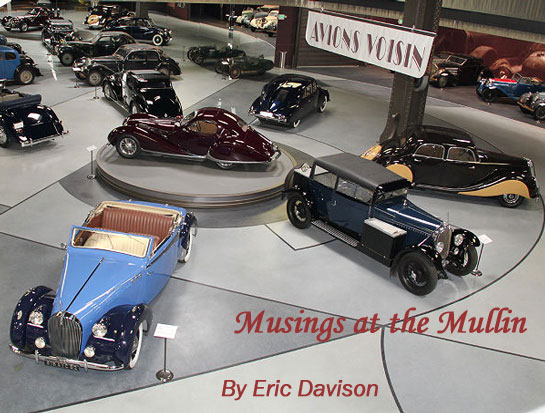
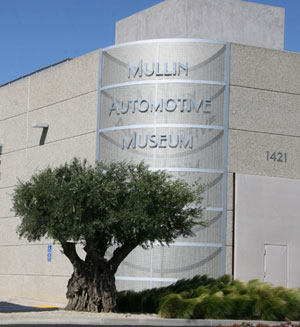
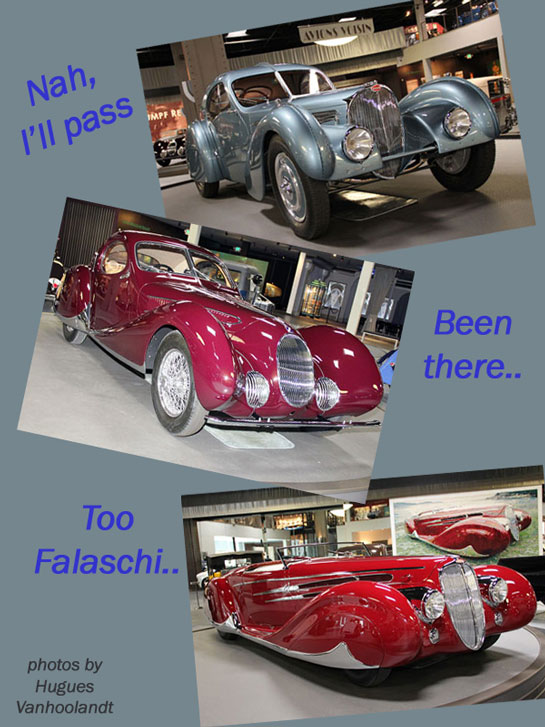
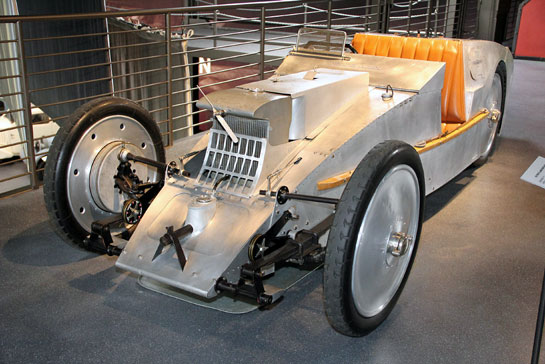
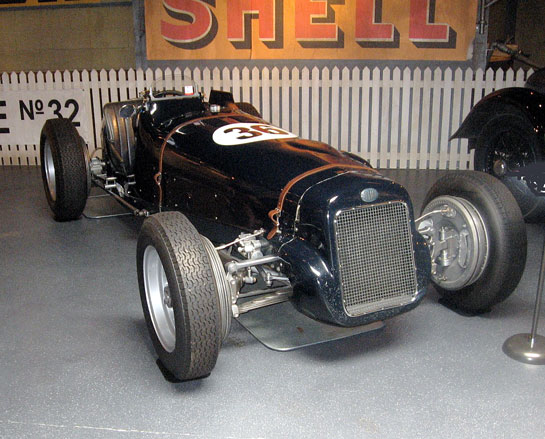
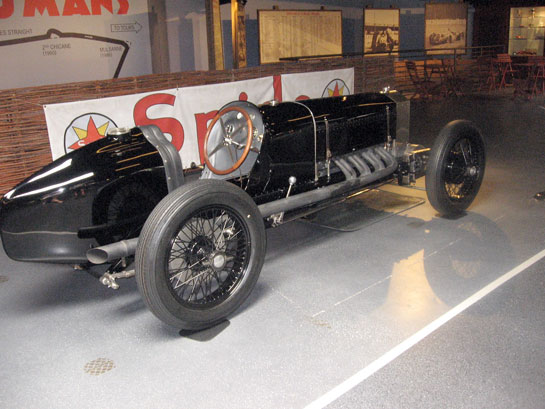
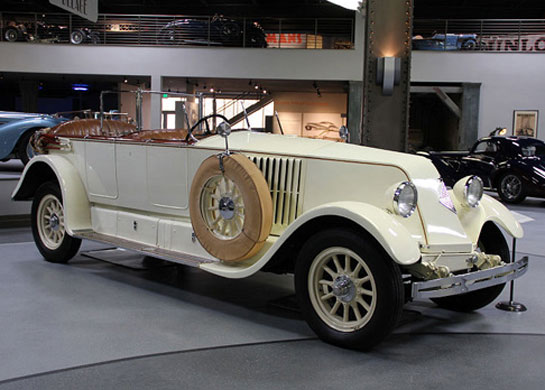
When Eric mentions the liveried chauffeur in the dual cowl Renault, it reminds me that Lord March , he who sponsors and presents the Goodwood events, urges attendees to wear period clothing so as to better capture the ambiance of the original era of the motorcars. I wish that Monterey Historics or some other vintage racing or concours event in America would make similar entreaties because those of us who can’t afford to field a car could at least find some vintage duds. Then the pictures of a ’50s car we take wouldn’t look so out of sync as they do now with a 1950s car surrounded by people wearing modern clothes.
In the spirit, I’ve got my Giorgio Armani hornrims, suitably smoked as they used to say, and would like to find a pair of plus fours, until then will just wear off white linens and a poh’ boy hat. Wish I could afford one of those hand-woven Peruvian straw hats of suitable brim width.
Alas I don’t know if there is a modern equivilent of the “pudding bowl” helmet that would pass the current helmet requirement–that is what really looks out of place when I look at the pictures I take at Monterey–a ’50s car with a driver wearing a full coverage helmet right out of 2011!
Going back to the chauffeur, I think I’ve seen a couple at Pebble, and enjoyed the ladies’ finery with colors related to the car being shown so Pebble is at least the first step in achieving the vintage look. I’d stop short of dyeing the poodle to match the car, though, as once was the case in French and Italian concours because maybe the other poodles would look askance at a lavender poodle (but on the other hand, hey, they’re French…)
Nice article. On the other hand, if you venture into French language, get it right.
So Belle Epoque is like this; and the Train bleu [Blue train] was starting from a station, indeed and gave its name to the Restaurant, correct
Best regards
PM
Very nice article but Mark Dees’s book, “The Miller Dynasty” has the Cooper beinga slavish copy of the Millers of the day but Harry Miller having nothing to do with it. Dees interviewed Reeves Dutton, who was Cooper’s mechanic for years and found that Buick was involved with the financing and engineering of the car but pulled out before the car raced a lap. An aside – Dutton lived to the ripe old age of 101!.
After spending many days in the Mullin Museum since it was an empty commercial building, I have not been able to craft as beautiful a visit as Eric has created. I agree completely on all counts. And I agree with Paul on the FWD Cooper, but it remains a wonder-filled non sequitur at The Mullin—not unlike the world’s best Tatra. Thank you Eric, and thank you Peter.
I am jealous of your chance to visit at the fantastic Mullin museum, but I greatly enjoyed your article. Just a few additions. The 1923 Voisin ‘Laboratoire’ (officially C6 Course) was in fact developed by André Lefebvre, the young French engineer who was then head of Voisin’s small racing and development department. Hence the name Laboratoire. The C6 course had no conventional chassis but was, as far as we know, the first racing car with a body-cum-chassis or monocoque construction. It resembled indeed the fuselage of an airplane. However, because Lefebvre knew about ‘lift’, its profile was not like that of an airplane wing, contrary to that of the 1923 Bugatti ‘Tanks’.
Lefebvre had studied at the Ecole Supérieure de l’Aéronautique et de Construction Mécanique (Supaéro) in Montmartre and during World War I joined Voisin’s aircraft factory in Issy-les-Moulineaux. After the armistice Gabriel Voisin had to switch his factory to producing cars instead of fighters and bombers. Because he realized that he knew more about planes and buildings (he had studied architecture) he bought the drawings and three prototypes of a large and luxurious automobile. This was designed at the request of André Citroën by Ernest Artault and his friend Louis Dufresne. The latter had worked for Panhard. Gabriel Voisin and his ‘spiritual son’ André Lefebvre then perfected this design until he was convinced that it could bear the name the Avions Voisin C1. The early Voisins were very successful. Not only commercially but also in touring car races. But Gabriel Voisin got angry with the organising French Automobile club as they were going to forbid aerodynamic shaped bodies. For this reason he decided to engage four cars in the 1923 Grand Prix de Tours. André Lefebvre was not only largely responsible for the construction of these cars but he also participated with one of them in the Grand Prix, finishing in fifth place. He later developed and drove a number of Voisin record breaking machines. After Voisin got into financial problems around 1930, Lefebvre moved to Citroen were he became the chief engineer of the Bureau d’Etudes and created the Traction Avant (1934), the TUB (1939), Citroën’s first front-wheel drive utility van that was succeeded by the H and HY vans (1947), the Deux Chevaux (1948), and, last but not least, the DS (1955).
Gijsbert-Paul berk, Airion, France
‘Way back when, I read that Voisin said he was truly the first to “fly,” as his plane took off under its own power, flew some distance, made a turn, and landed; unlike the Wright’s catapult launch straightline flight. This might’ve been in an AQ 35 years ago or so. The article mentioned that his aerodynamic ideas were so far advanced for that particular moment in time that he was given a government dinner, at which a high official announced that all future French planes would by law be built to Voisin’s patents, making him instantly wealthy. But he’d had an extra bit of wine, so he leaped to his feet and said, “I give my patents to France!” and then sat down and realized what he’d given away. The article said that while many wealthy Frenchmen had stables of horses, ol’ Gabe had a stable of ballet dancers; and the last years of his life he and his wife lived in one of those houses his mistress was kind enough to loan back to him. But his aeronautical ideas were soon superceded and yet by law the French aeronautical industry couldn’t keep up, so French WWI pilots cursed Voisin for the obsolete planes they were forced to fly.
p.s. Has Mr. Davison been to the Nicolis museum, on the main road of whatever big Italian town is a couple dozen miles north of Mantova? It’ll blow your sox off, sterilize them, and put ’em back on your feet!